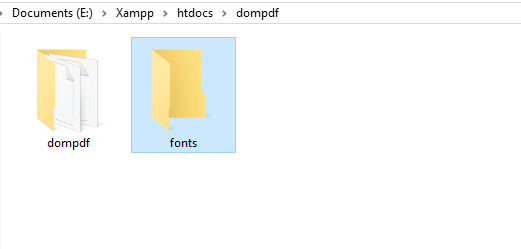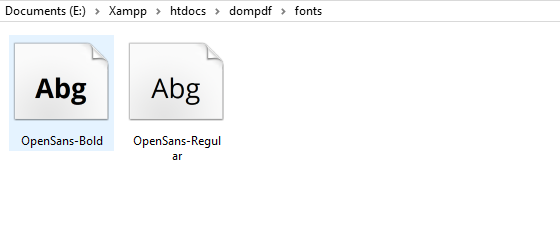When generating a PDF with Dompdf then it ignores fonts that are not available in its internally – Helvetica, Times-Roman, Courier, Zapf-Dingbats, Symbol.
Require to load the fonts for use in PDF creation which is not existing in Dompdf internal fonts.
In this tutorial, I am creating a PDF of MySQL database table records and set its font-family using Dompdf.

Contents
1. Download
- Download Dompdf latest version from here.
- Copy and extract it in your project directory.
2. Table structure
Create users table and add some records.
CREATE TABLE `users` ( `id` int(11) NOT NULL PRIMARY KEY AUTO_INCREMENT, `username` varchar(100) NOT NULL, `name` varchar(100) NOT NULL, `email` varchar(100) NOT NULL ) ENGINE=InnoDB DEFAULT CHARSET=utf8;
3. Configuration
Create a config.php for the database connection.
Completed Code
<?php
$host = "localhost"; /* Host name */
$user = "root"; /* User */
$password = ""; /* Password */
$dbname = "tutorial"; /* Database name */
$con = mysqli_connect($host, $user, $password,$dbname);
// Check connection
if (!$con) {
die("Connection failed: " . mysqli_connect_error());
}
4. Copy fonts
- Create a new
fontsfolder at the project root.
- Copy your fonts which you want to use in your pdf to the
fontsfolder. I have copiedOpenSans-Regular.ttfandOpenSans-Bold.ttfto the folder.
5. Create PDF and set font-family
Create a new pdf.php file.
Load Fonts and Use it
Create $html variable to store data in HTML format for pdf generation.
Load fonts using @font-face CSS rule.
In the example, I am loading OpenSans-Regular and OpenSans-Bold fonts.
Pass the file path in src.
Now, use these fonts in the selectors.
I used 'OpenSans-Bold' in <table > header columns and 'OpenSans-Regular' in <table > body columns.
Add data and create a PDF
Fetch all records from the users table and create new rows.
Create an object of Dompdf and pass $html in loadHtml() method.
Completed Code
<?php
include "config.php";
$html = "<style>
@font-face {
font-family: 'OpenSans-Regular';
font-style: normal;
font-weight: normal;
src: url(http://" . $_SERVER['SERVER_NAME']."/dompdf/fonts/OpenSans-Regular.ttf) format('truetype');
}
@font-face {
font-family: 'OpenSans-Bold';
font-style: normal;
font-weight: 700;
src: url(http://" . $_SERVER['SERVER_NAME']."/dompdf/fonts/OpenSans-Bold.ttf) format('truetype');
}
table thead tr td{
font-family: 'OpenSans-Bold';
}
table tbody tr td{
font-family: 'OpenSans-Regular';
}
</style>";
$html .= "<table border='1' width='100%' style='border-collapse: collapse;'>
<thead>
<tr>
<td>S.no</td>
<td>Username</td>
<td>Name</td>
<td>Email</td>
</tr>
</thead>
<tbody>
";
$usersData = mysqli_query($con,"select * from users");
$sno = 1;
while($row = mysqli_fetch_assoc($usersData)){
$html .= "<tr>
<td>".$sno++."</td>
<td>".$row['username']."</td>
<td>".$row['name']."</td>
<td>".$row['email']."</td>
</tr>";
}
$html .= "</tbody></table>";
$filename = "newpdffile";
// include autoloader
require_once 'dompdf/autoload.inc.php';
// reference the Dompdf namespace
use Dompdf\Dompdf;
// instantiate and use the dompdf class
$dompdf = new Dompdf();
$dompdf->loadHtml($html);
// (Optional) Setup the paper size and orientation
$dompdf->setPaper('A4', 'landscape');
// Render the HTML as PDF
$dompdf->render();
// Output the generated PDF to Browser
$dompdf->stream($filename);
6. Conclusion
Use @font-face CSS rule to load your font-family and use it in your required selector.



